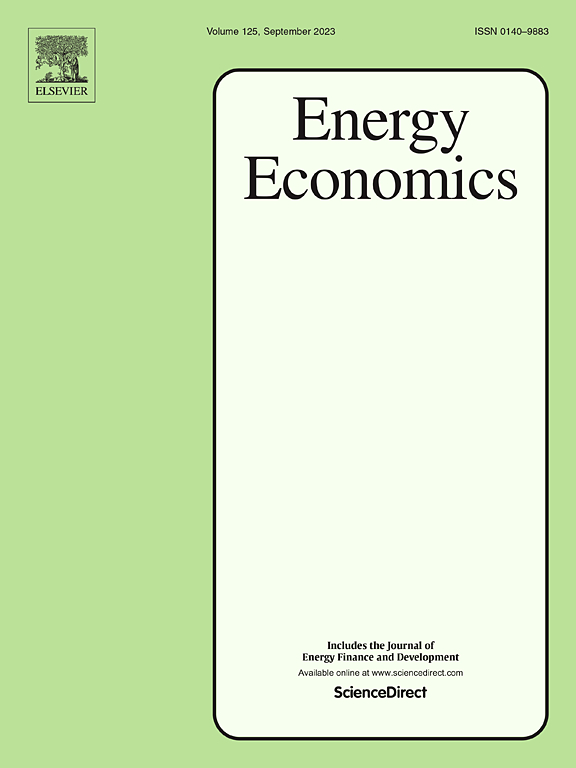Green innovation drives the realization of carbon neutrality and the weak Porter effect
IF 14.2
2区 经济学
Q1 ECONOMICS
引用次数: 0
Abstract
Achieving carbon neutrality involves complex economic, social, and environmental systems. At first, this paper categorizes goods into ordinary, low-carbon, and zero-carbon goods based on extended carbon footprint labels. Second, based on the green Schumpeterian endogenous growth model, it establishes an economic dynamical system by modeling the production of different goods to explore the effects of four key points for emission reduction – carbon tax, green values dissemination rate, new energy extraction capacity, and carbon emission control rate – on the evolution of the three core elements of carbon neutrality: green innovation, energy structure, and green consumption preferences. Finally, it explores the pathways to achieving carbon neutrality and economic growth. The findings highlight two points. Firstly, there exists a pathway to achieve carbon neutrality while maintaining economic growth. Green innovation is the foundation for carbon neutrality, and its combination with higher carbon tax and faster dissemination of green values creates dominant role in achieving carbon neutrality and producing resultant force in reducing both carbon emission and carbon intensity. Meanwhile, enhancing both new energy extraction capacity and carbon emission control rates (as part of the combination of emission reduction points) are effective supplementary approach to attaining carbon neutrality. Lowering the discount rate facilitates achieving carbon neutrality while maintaining economic growth. Finally, the relationship between optimal carbon tax and green innovation exhibits a weak Porter effect, i.e., an inverted U-shaped relationship between these two elements, and the incentive effect of carbon tax on green innovation gradually weakens as green innovation advances.绿色创新驱动碳中和的实现,波特效应弱
实现碳中和涉及复杂的经济、社会和环境系统。本文首先根据扩展的碳足迹标签将商品分为普通商品、低碳商品和零碳商品。其次,基于绿色熊彼特内生增长模型,通过对不同商品生产进行建模,建立经济动力系统,探讨碳税、绿色价值传播率、新能源开采能力和碳排放控制率四个减排关键点对绿色创新、能源结构和绿色消费偏好三个碳中和核心要素演进的影响。最后,探讨了实现碳中和和经济增长的途径。研究结果强调了两点。首先,在保持经济增长的同时,存在实现碳中和的途径。绿色创新是碳中和的基础,它与更高的碳税和更快的绿色价值传播相结合,在实现碳中和方面发挥主导作用,在降低碳排放和碳强度方面产生合力。同时,提高新能源开采能力和碳排放控制率(作为减排点组合的一部分)是实现碳中和的有效补充途径。降低贴现率有助于在保持经济增长的同时实现碳中和。最后,最优碳税与绿色创新之间的关系呈现弱波特效应,即两者之间呈倒u型关系,并且随着绿色创新的推进,碳税对绿色创新的激励作用逐渐减弱。
本文章由计算机程序翻译,如有差异,请以英文原文为准。
求助全文
约1分钟内获得全文
求助全文
来源期刊

Energy Economics
ECONOMICS-
CiteScore
18.60
自引率
12.50%
发文量
524
期刊介绍:
Energy Economics is a field journal that focuses on energy economics and energy finance. It covers various themes including the exploitation, conversion, and use of energy, markets for energy commodities and derivatives, regulation and taxation, forecasting, environment and climate, international trade, development, and monetary policy. The journal welcomes contributions that utilize diverse methods such as experiments, surveys, econometrics, decomposition, simulation models, equilibrium models, optimization models, and analytical models. It publishes a combination of papers employing different methods to explore a wide range of topics. The journal's replication policy encourages the submission of replication studies, wherein researchers reproduce and extend the key results of original studies while explaining any differences. Energy Economics is indexed and abstracted in several databases including Environmental Abstracts, Fuel and Energy Abstracts, Social Sciences Citation Index, GEOBASE, Social & Behavioral Sciences, Journal of Economic Literature, INSPEC, and more.
 求助内容:
求助内容: 应助结果提醒方式:
应助结果提醒方式:


